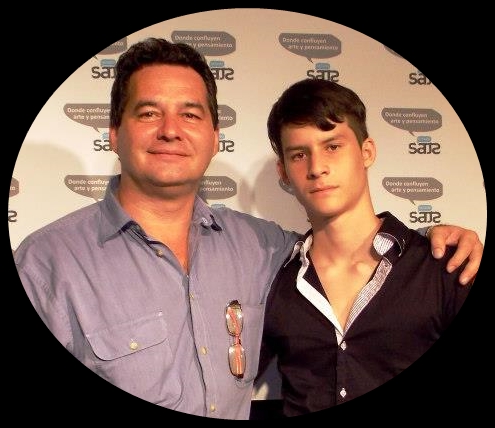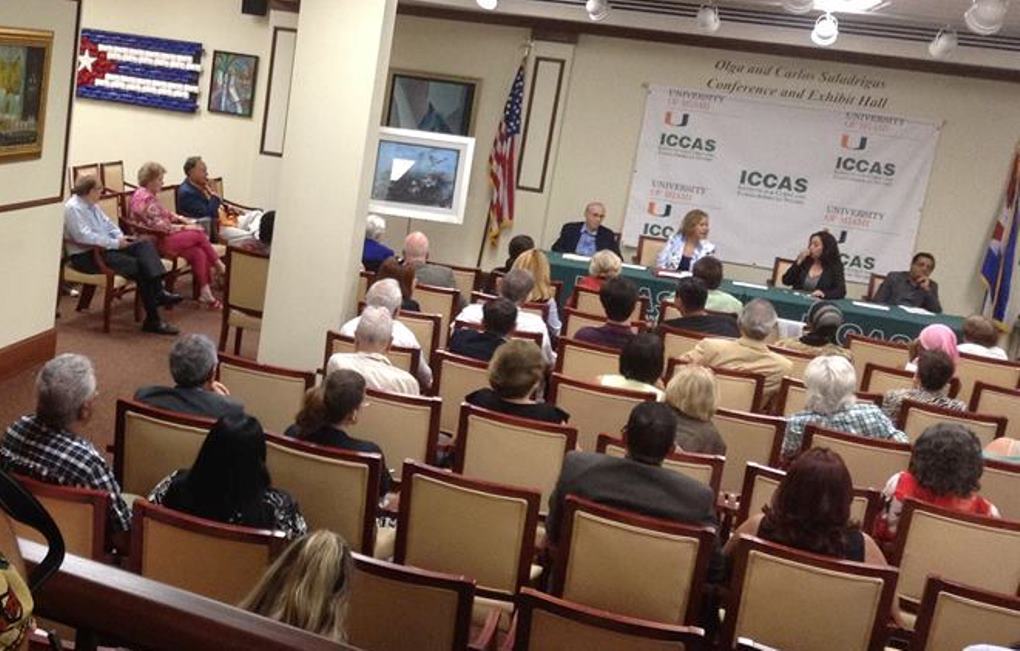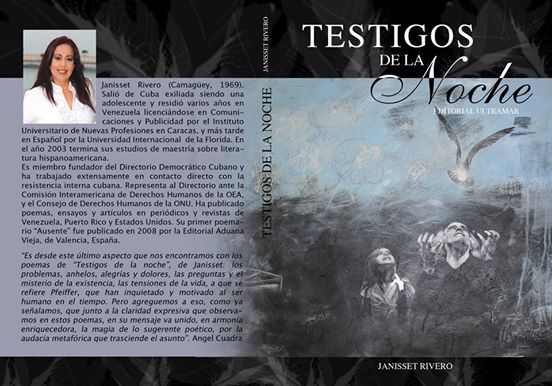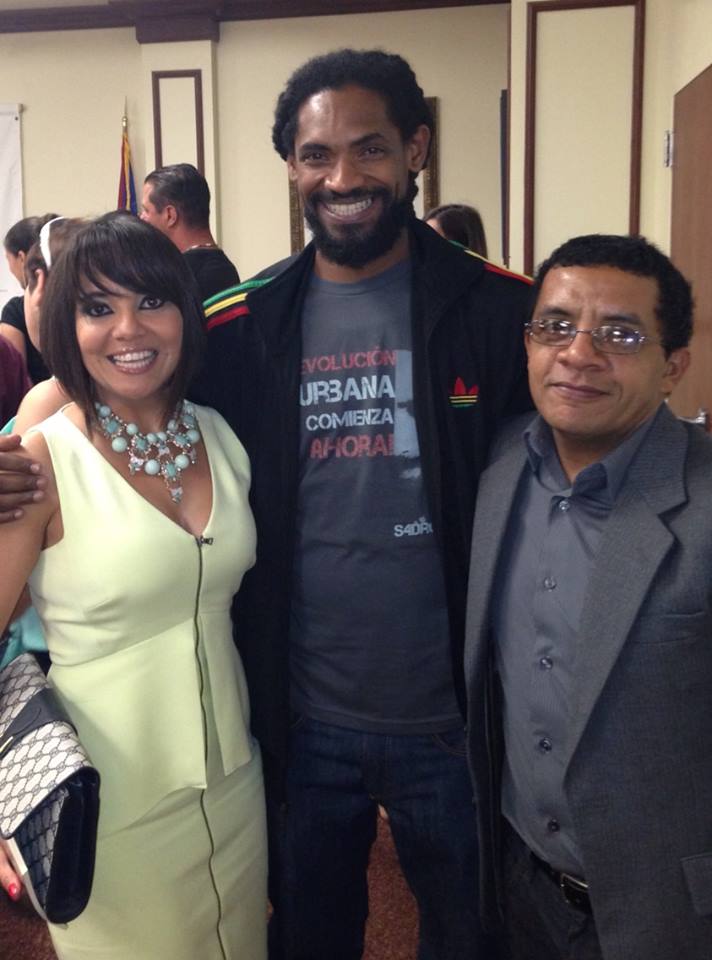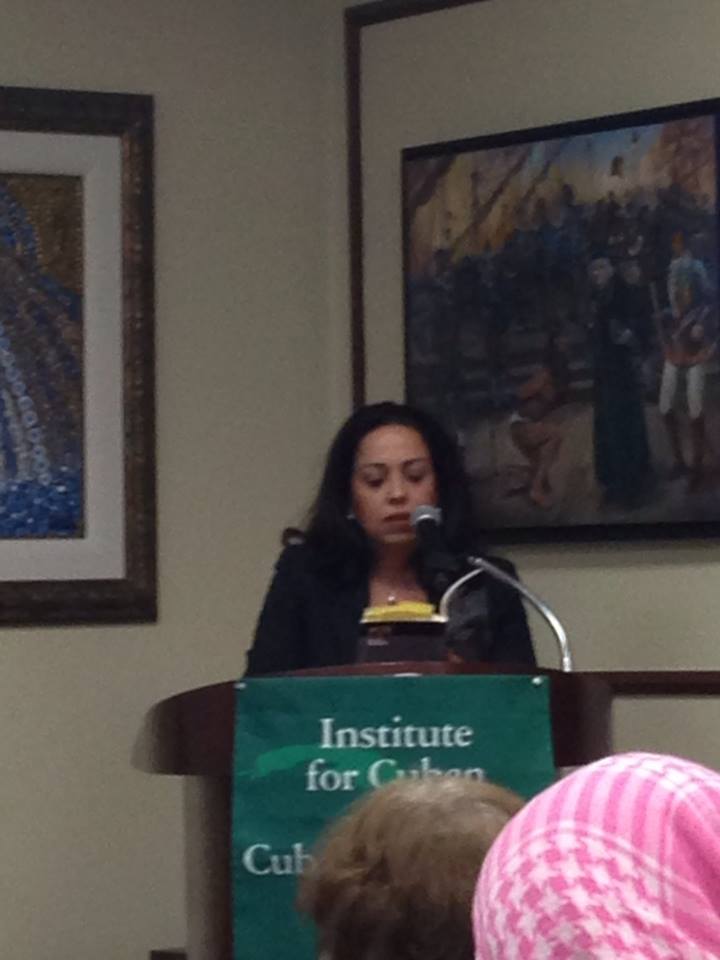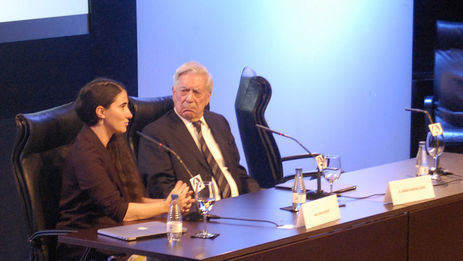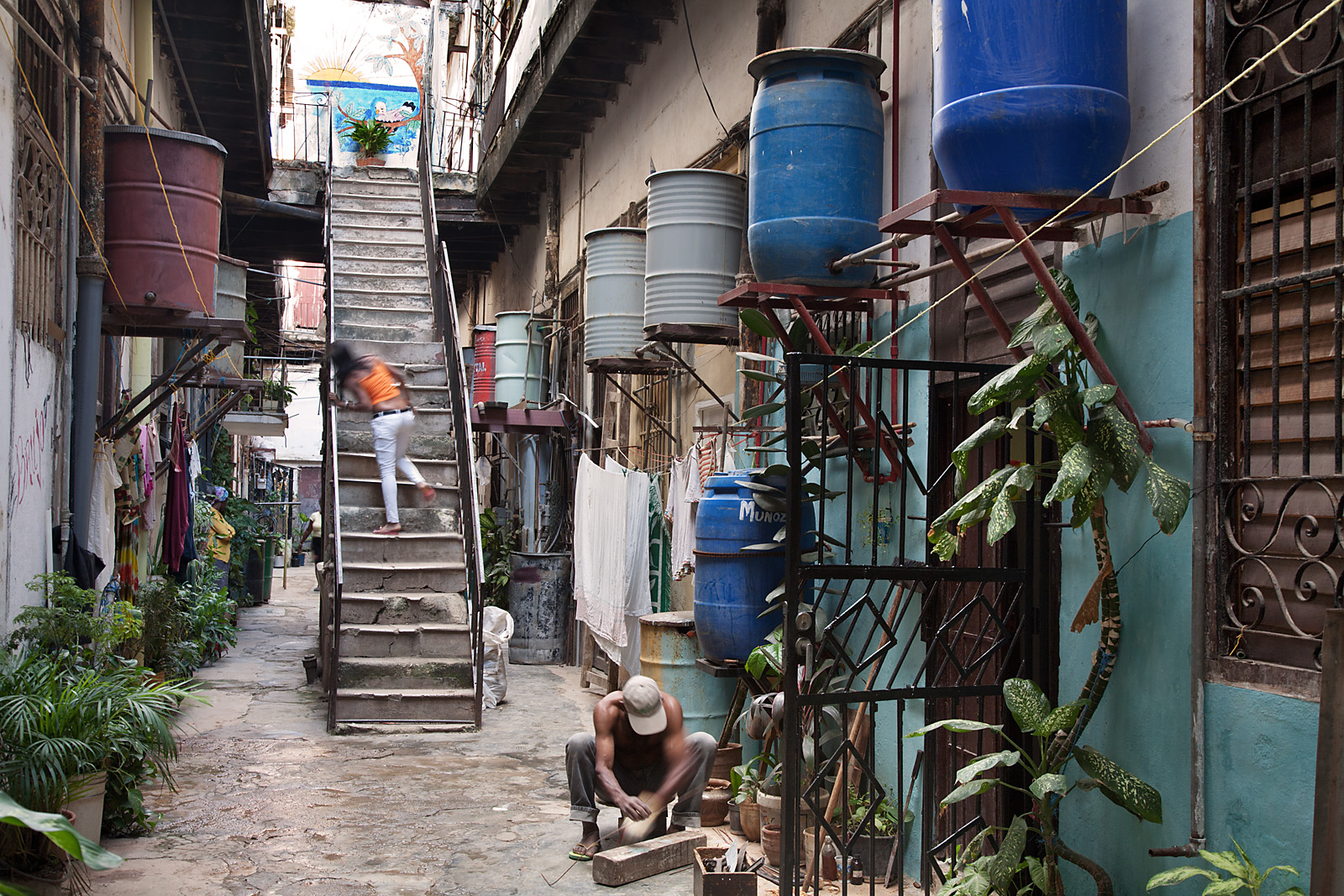It seemed as if the nightmare was something from a remote past, but the truth is that when we awoke, the dinosaur was still there. We haven’t found out — and perhaps will never know — if the media folly was a reaction to an insidious rescue operation, a whimsical expression of favoritism, or a simple show of irresponsibility.
It doesn’t matter. Seen from the perspective of today — the chain reaction it provoked, of which the cycle we are beginning is a link — it was a suicidal act. It threw down a challenge without having the slightest idea of the adversary’s level of expertise, nor of the solidity of a cultural policy that has reinforced itself like an irreversible phenomenon by means of practices that have been going on for three decades now.
This battle having been clearly won — I won’t say the war because the swaggering is not so much the expression of a political tactic as it is a world view based on suspicion and mediocrity — we can open a path to reflection telling ourselves, simply, that what is happening is fitting. We have proof of this in the decision of the Ministry of Culture to support Desiderio [Navarro]’s initiative, coinciding with Abel [Prieto]’s, insofar as filling the void of information and analysis which has prevailed up to now in the area of cultural — that is, anti-cultural — policy, since the first half of the seventies.
As incredible as it may seem, the person who directed the “Imprint” program dedicated to Pavon — whose script had been written by a friend — assured us that she didn’t know who the character was or, more exactly, that she didn’t know what “imprint” the character had left on Cuban culture during his term as President of the National Cultural Council. Nor would she know it afterwards, because it was covered in a careful mantle of silence in the program. It wouldn’t do to mention a rope in the house of a hanged man. continue reading
Well, we had not left our amazement when a little voice began to hammer our ears: “And why so hard to believe? Why did the young director have to know? Have you, the old people who lived and suffered through that stage, written a book or pamphlet, published a series of articles, led a series of talks on the subject?
In recent years the reporting of individual violations of the perverse display of prejudice, the cynicism of the explanations has been made by the victims in interviews, articles, awards acceptance speeches, but the analysis of the phenomenon was being postponed as have been other things that deserved to be discussed, and for the same reason: to avoid jeopardizing the unity. Along with the historical validity of our national project, the unity is the only thing, in fact, that ensures our superiority over enemies and adversaries.
But just as we should not forget that in a place permanently besieged, as is our country, insisting on differences and disagreements equivalent to “giving ammunition to the enemy” …, it must be remembered that the covenants of silence are often highly risky, because they create a climate of immobility, a unanimous mockery that prevents us from measuring the true extent of the dangers and the integrity of our ranks, in which often slip loquacious opportunists.
We know these drills and maneuvers conducted in Europe and especially in the USSR, and in the latter case, I believe, because even our own militants, among them not a few heroes of labor and descendants of heroes of the war, had been definitively demobilized by the bureaucracy and routine.
Without being a specialist in the field, I dare ask the unfathomable question: “Why not go the workers, especially the communist militants, to defend the Revolution in the USSR?” Very simple: “Because no instructions from above were given.”
We need to stand firm in our trenches, which, of course, are not the best places to exercise democracy, but that does not mean we can afford to abandon the practice of criticism and self-criticism, the only exercise that can set us free of triumphalism and save us from ideological deterioration.
2
I would not want to weary you with ramblings and criteria that many of you share and that could get us away from our subject. This, as suggested by the title of my talk, proposed by Desiderio, aims at the reasons and practice of Five Grey Years.
I invented the label for methodological reasons, trying to isolate and describe that period so I looked at its dominant trait and featuring contrasts with the previous stage, characterized by its color and its internal dynamics (although not without, as we shall see, frustrations and surprises [1].
But before we go on I would like to make a couple of points clear. First, from where I speak, that is, from what life experience, from which ideological and political position I project my views and reviews on the subject, and in general on issues of culture, their production and reach, with an emphasis on literature-especially-narrative, which is the only field I know from experience. I quickly speak like this because I fear to say anything that seems incomprehensible or strange to some of the young people present.
I come, obviously, from a world that marked my position on many of these problems: the world of pre-revolutionary Cuba, the former republic. From a young age I wanted to write. I would not dare to say I wanted to be a writer because it was a job without a professional profile that could attract suspicion or derision.
“I did not tell anyone I wanted to be writer,” [2] José Soler Puig confessed to a friend, “because people laughed and even thought that was a job for feminine men”
And Virgilio Piñera, in a public message addressed to Fidel in March 1959: “… We, the Cuban writers, we are ’the last card in the deck’, we mean nothing when it comes to economic, social and even in the field of the Letters itself. We want to cooperate shoulder to shoulder with the Revolution, but this requires that we remove the miserable state in which we struggle.” [3]
As you can see, the level of self-esteem of the guild was on the floor. Perhaps the writers’ anecdotes, vain or boastful, irritated or amused his confreres in the corridors of Madrid or Paris, but here were tales of aliens, since the writer was literally outside the circle of his closest friends and the four cats who read Origenes [Magazine] (lucky cats, by the way).
It still seems a miracle that two years after the message of Virgilio I was already editing The Adventures of Tom Sawyer and testimonials of mountain children at the Ministry of Education, led by Herminio Almendros, and soon also Proust, Joyce and Kafka for the National Publisher, led by Alejo Carpentier.
From this perspective it became clear that we began to consolidate an alliance between political and artistic avant-garde. The Revolution — the real possibility of life-change — appeared to us as the political expression of the avant-garde artistic aspirations.
So when it began to show its hairy ear of homophobia and then masked the socialist realism, we felt quite confused. What did this have to do with phenomenon so deep, they really had changed the lives of millions of people, making the illiterate literate and feeding the hungry, not letting a single child go without a school, promising to sweep away racial discrimination and machismo, placing in bookstores, at the price of fifty cents or a dollar, all literature, from Homer to Rulfo, from Daphnis and Chloe to my uncle the employee … what did an event of these dimensions have to do with my sexual preferences or the pilgrim image of a virtuous and virile artist, always willing to sing the glories of homelands?
We, the young people whom we thought were the heirs and representatives of the artistic and literary vanguard could not communicate that vision … a serious problem, since in dogmatic circles gaining strength came the idea that aesthetic discrepancies concealed political differences.
Moreover, one could not deny that the new responsibilities also discovered their own shortcomings. If suddenly we had the opportunity to address the millions of potential readers, we could not help but wonder: What now, how to write or, in the case of publisher, to publish?
Is “what everyone understands, what the officials understand,” as Che ironically said? Do we have what “the people like”, thus leaving it stuck in the lowest level, or what I like, so that people refine their tastes and one day become as educated as I am?
Populism, paternalism, elitism, high culture, popular culture, and mass culture for the masses … ghosts of ideological dilemmas and, finally, beginning to traverse on our way, often taking us by surprise …
What I mean is that you have some patience, because it is impossible to speak of the Five Grey Years without referring to the origins of certain conflicts that were incubated in the late seventies. [4]
I will only refer to those who, as mentioned, touch us more closely, others, like the microfraction, for example, beyond the limits of our subject (although they continue to be associated with it because it was a bad sectarianism widespread among intellectuals and political cadres directly linked to the field of ideology).[5]
3
Socialist realism — literature as pedagogy and hagiography, methodologically oriented toward creating “positive heroes” and the strategic absence of antagonistic conflicts in “among the people” — produced in us, my petit bourgeois friends and I, the same reaction someone experiences when a fly is found in the glass of milk.
Among the Cuban narrators no one, as I recall, had accepted the invitation, but the newly established National Press published heavily edited Soviet novels (some respectable, indeed, such as Sholokhov and those of Alexander Bek — The Highway, by Volokolamsk and Men by Panfilov, actually two parts of the same epic — that accompanied many militants in the frequent demonstrations of the time).
In any case, I, as a young intellectual with no political ideology other than that of Fidel’s (I used to say at the time that I had become a Marxist by watching television, i.e. listening to Fidel), I had two things absolutely clear: return to the past? It was not going to happen. Accept as cultural horizon a manual by Konstantinov and normative aesthetics? No way.
But I would not want to fall into the same thing we criticize, and I know when it comes to defending our truth, our point of view, we tend to be as categorical and dogmatic as the adversary. Socialist realism was not “intrinsically evil”, what was intrinsically evil was the imposition of this formula in the USSR, where what could have been a school, one more literary and artistic current, suddenly became the mandatory official doctrine.
Of the various roles that plays or that literature and art can play — aesthetics, recreation, informative, teaching — the commissars moved the latter to the foreground, to the detriment of the other, what the people and particularly the working class needed was not just simply reading — opening new horizons of expectations — but to educate themselves, assimilate through reading the norms and values of the new society.
This admirable purpose — admirable in theory, and especially since its foundation dating back to the Enlightenment was not aware that “if art educates,” and I quote Gramsci for the umpteenth time, “it does as art not as educative art, because if it is educative art it ceases to be art and an art that denies itself cannot educate anyone.”
We did not even suspect that the legacy of scholastic Marxism was as strong among us, or at least among some intellectuals from the Popular Socialist Party, but one of our most brilliant and respected essayists, Mirta Aguirre, wrote in October 1963:
“Today, in the hands of dialectical materialism, art can and should be a form of exorcism: a form of knowledge that contributes to sweep the minds of men free from the Caliginous shadows of ignorance, a valuable tool for replacing the religious conception of the world by its scientific conception and quick Marxist resource of the defeat of the philosophical idealism.” [6]
One was tempted to ask: can and should art be all that? Or, with a certain nonchalance: is that all that art can and should be? If it had, it would not have taken long to discover that our bewilderment had a shady class origin, because what really happened was that certain ideas were “precarious and on their way to extinction; some intellectuals and artists, “instead of engaging to remove traces from themselves of the ideological remains of a collapsed society,” stubbornly insisted on justifying them. [7]
Actually, what we saw was that under that rigid and precarious artistic guidance model the line between art, education, propaganda and advertising was becoming blurred. The funny thing is that capitalism produced tons of publicity and advertising without mentioning it and even cleverly disguised it under the labels of information and “entertainment.”
But socialism was young and inexperienced; in the famous controversy of December 1963 between Blas Roca and Alfredo Guevara around the display of several films (the Sweet Life by Fellini, Accatone by Pasolini, The Exterminating Angel by Buñuel and Alias Gardelito by Lautaro Murua), Guevara pointed to the newspaper column of Blas Roca — a very respectable man, in other respects — as a column that so superficially addresses the problems of culture, art and film in particular, reducing its significance, if not its function to that of the revolutionary illustrators, seen by others in its immediate perspective. [8]
Needless to clarify, because in politics, as Marti said, the real is not seen — that these aesthetic disputes were part of a struggle for cultural power, for control of certain areas of influence. This became evident in 1961 with the controversy over the movie PM and the subsequent closure of the publication Lunes de Revolución, a measure that led to the creation of La Gaceta de Cuba, a literary publication from the Writers and Artists Union (UNEAC) that has lasted until today.
The movie PM turned out to be a historic controversy because it gave rise to “Words to the Intellectuals,” Fidel’s speech which fortunately has served ever since — except during the dramatic pavonato interregnum — as a guiding principle of our cultural policy.
PM was a modest free-cinema essay, a little documentary of Saba Cabrera Infante and Orlando Jiménez Leal which had passed unnoticed by television in a program sponsored by Lunes de Revolución, i.e. by Carlos Franqui and Guillermo Cabrera Infante. The two — Franqui and Guillermo — had one great virtue: a vision of a modern and dynamic art, literature and journalism, as evidenced by the Revolution newspaper and its literary supplement, Lunes (Monday).
But both had also a major flaw, given the circumstances: they were anti visceral, and hated anything that smacked of the Soviet Union and the PSP. The ICAIC refused to display PM in theaters, sparking the controversy. [9] One would say that at some point both the leadership and the intelligentsia ICAIC PSP rose to the top leadership of the government these dramatic questions: Who are the ones to make films in Cuba? Who are the ones to institutionally represent our writers and artists? The answers were falling from the tree.
But something had slipped from our hands, because during the second half of the decade events occurred that would have dire consequences for the normal development of revolutionary culture: the establishment of the Military Units of Assistance to Production (UMAP), for example — which lasted three years and left a few scars — and the institutional rejection of two prizewinning books from the Union of Writers and Artists of Cuba (UNEAC) literary competition (The Seven Against Thebes by Antón Arrufat, and Out of the Game, by Heberto Padilla), not to speak of passing stories, albeit symptomatic ones, such as the hostile climate aroused among certain functionaries by the appearance of Lezama’s Paradiso (1966), owing to its supposed exaltation of homoeroticism (it was said that copies had been ordered removed from some bookstores).
The unfortunate UMAP initiative, the idea of young homosexuals as well as religious people — above all Jehovah’s Witnesses, who by conviction rejected the use of arms — fulfilling their military service in work units, not combat units, seemed related to the male chauvinist vision of those bourgeois fathers who would send their most rebellious or fearful sons to military schools to “make men out of them.”
I remember having told the friend to whom I previously alluded, when he asked me about discrimination against homosexuals in Cuba, that this attitude had nothing to do with the Revolution, that it was coming to us from ages past via the dual track of Judeo-Christian morality and ignorance, but that perhaps the emotional climate of that permanently besieged place (Cuba) — which included the constant exaltation of virile virtues — as well as the obsession for straightening out so many twisted aspects of the old society, caused us to want to straighten or restore homosexuals, too, who not surprisingly had always been referred-to by euphemisms such as inverts or effeminates. [10]
I totally reject the idea, because it seems to me cynical and inexact, that this naive or stupid voluntarism has anything to do with the aspiration to form a “New Man” — one of the most cherished longings of man, preceding even Christianity — such as was articulated in our environment by Che and as we would ourselves repeat, alluding to Plautus’s homo homini lupus — so quoted by Marx — when we would speak of a society where man would not be wolf to man, but rather his brother.
Now, I am convinced that the pathological level homophobia, as institutional policy, during the Five Grey Years, is a subject of concern not so much to sociologists but to psychoanalysts and priests, that is, to those professionals capable of peering fearlessly into the “obscure abysses of the human soul.” It also would not be superfluous to reflect on those repressive or “disciplinary” methods invented by the bourgeoisie and so well-studied by Foucalt in some chapter of Keep Watch and Punish.
4
The prizewinning books by Padilla and Arrufat in the UNEAC competition were published with a prologue in which the institution asserted its disagreement with them: they were works that served “our enemies,” but now were going to be useful means to other ends, one of which was to “outline openly the ideological struggle.”
It was then — between November and December of 1968 — when in the magazine Verde Olivo (“Olive Green”) appeared five articles whose authorship is attributed to Luis Pavón Tamayo, an unprovable conjecture because the author used a pseudonym — the sadly famous Leopoldo Ávila — who has yet to be revindicated by anyone.
The first article expouned on the conduct of Guillermo Cabrera Infante who, just a few months earlier, in the magazine Primera Plana of Buenos Aires, had declared himself a fervent enemy of the Revolution…after having strenuously served it during several years as Cultural Attache’ in Brussels.
The two following articles dealt aggressively with Padilla and Arrufat; and the last two, with issues in the intellectual sphere, among them the level of “depolitization” from which, in Ávila’s opinion, our own writers and critics were suffering [11].
I don’t need to emphasize the tense climate that prevailed in those months, because already a group of colleagues — Cubans (Retamar, Desnoes, and I) as well as Latin Americans (Roque Dalton, René Depestre and Carlos Mari’a Gutiérrez) expounded our ideas on the matter in a round table of sorts that we held in May of 1969 and which was published, first, in the magazine Casa de las Americas (“Americas House”) and later in Mexico, by Siglo XXI (“Century XXI”), under the predictable title of The Intellectual and Society [12].
The ideological tournament announced by Avila was hinted at in occasional skirmishes, but had been gradually acquiring an increasingly international character due in part to the attacks on the Revolution that various intellectuals had made in Europe — Dumont, Karol, Ensensbert — and in part also because one of the panelists that had awarded the prize to Arrufat and Padilla, the English critic J.M. Cohen, decided to participate in his way in the debate.
To all this was added the appearance in Paris of the magazine Mundo Nuevo (“New World”), edited by the Uruguayan critic Emir Rodriguez Monegal; very soon thereafter his countryman Angel Rama, relying on reports in The New York Times, denounced the publication as a “cultural facade of the CIA” [13]. In the opinion of the specialists, Mundo Nuevo’s ultimate purpose was to dispute Casa de las Americas convening power and to undermine the image of the “committed” artist or writer that the Cuban Revolution had been proposing as a model for the intellectuals of our America [14].
It was this model, to be sure, that for us served as the reason or basis for the famous “Letter to Neruda” which towards the end of 1966 we caused to be circulated throughout all corners of the continent, and was also what prevailed a year later in the Preparatory Seminar of the Havana Cultural Congress, where it was revealed that a large contingent of our intelligentsia was working out, from Jose Marti’s thoughtand Marxist viewpoints, an anti-colonial school of thought, more in keeping with our reality and with Third World problems than with Eurocentric ideological currents running on both sides of the Atlantic.
The magazine Pensamiento Critico (“Critical Thought”) and the excellent catalog of social science publications that the recently created Instituto del Libro (“Institute of the Book”) was already promoting also fulfilled and important role in this bold process that we would call “consciousness raising” or “cultural decolonization”, and to which, for sure, none of the famous instructional manuals recently imported from the USSR, could contribute anything.
The Havana Cultural Congress was held in January, 1968, with hundreds of intellectuals and artists from the world over participating, in a climate of revolutionary optimism which objectively, nonetheless, was reduced to its minimal expression because hardly two months earlier Che had died in Bolivia — an event that was frustrating the nascent continental emancipation project that had started gestating in 1959.
Meanwhile, the international prestige of Cuban culture had grown thanks to the professionalism and creativity of artists and writers, on the one hand, and the work of cohesion and dissemination accomplished by the Casa de las Americas and the ICAIC on the other; there was the vigorous presence of the cinema, ballet, graphic design, theater, music (with the nascent Nueva Trova), the Conjunto Folklorico, and literature (this last manifesting two emerging modalities: the testimonial/novel and the Narrative of Violence). Observing such a panorama anyone could have said, alluding to Avila’s diagnosis: “If all this is the product of a depoliticized intelligentsia, may God come and see it”.
6
I would like to conclude this here with the general scheme of prehistory — viewed from a more or less fair perspective, more or less distorted by a participant who, as is natural, tends to bring his own perspective — but I’m afraid the rodeo isn’t over yet. There are still factors, as it were, objective and subjective, national and international that have to be taken into account to get to the point afterwards. So I ask you, please, a little more patience.
What occurred with Out of the Game following its publication we now see as the early stages of the “Padilla case”. He continued living a more or less normal life and announced (I don’t know if he actually gave) a recital at UNEAC of the poems in a book in progress that would have the suggestive title Provocacions — don’t be dirty minded, I was alluding to Arnold Hauser’s observation in the sense that works of art are, justifiably, challenging invitations to dialogue.
In December of 1968 Padilla even had a skirmish with Cabrera Infante in which, upon rejecting his support, he accused him of being a “counterrevolutionary who intends to create a difficult situation for anyone who has not followed his same path”…[15].
Because of a character flaw, Padilla could not remain for long in second place; he took advantage of a survey conducted by El Caiman Barbudo (“The Bearded Caiman”) to attack the editors because they were interested in Urbino’s Passion, the recently published novel by Lisandro Otero, while at the same time belittling Three Trapped Tigers by Cabrera Infante.
Every so often we would hear it said that he was very active as an impromptu consultant to diplomats and foreign journalists travelling through Havana, whom he would instruct on most dissimilar subjects: the destiny of socialism, worldwide revolution, emerging Cuban literature…
And one fine day in April of 1971 we received lamentable rumors, which later were confirmed as fact: that he had been jailed — for three weeks, according to some, or for five, according to others — and that he was going to make some public statements at UNEAC.
These turned out to be a pathetic mea culpa and a hasty list of accusations against friends and acquaintances, both absent and present. Knowing Padilla as we knew him, knowing that his long experience as a press correspondent in Moscow had turned him into an incurable skeptic, it is difficult to believe that his statement — so reminiscent of the shameful “confessions” in the Moscow trials — was not designed as a coded message, aimed at his colleagues all over the world.
Be that as it may, what is certain is that the message, the self-fulfilling prophecy, arrived at its destination. But already days prior, at his arrest becoming known in Europe, the process had been initiated which on this side of the Atlantic would result in the First National Congress on Education and Culture [16].
6
In effect, on the 9 April 1971, there had appeared in a Paris daily, Le Monde, an open letter which various European and Latin American intellectuals were addressing to Fidel to express their alarm at the arrest, which they saw as a possible new outbreak of sectarianism on the island.
It was like entering the lion’s den without taking proper precautions. I wouldn’t be surprised if it was that letter — and the unusual fact that among the signatories appeared Carolos Franque, now become zealous prosecutor of the Revolution — which precipitated the decision to convert the advertised First Congress on Education to First Congress on Education and Culture.This event took place in the conference rooms of the Habana Libre Hotel between April23-30.
In his closing address, Fidel would accuse as arrogant and overbearing those “bourgeois liberals”, instruments of cultural colonialism, that interfered in our internal affairs without the least notion of what our real problems were: the need to defend ourselves against imperialism, the obligation to attend to and provide for millions of children in the schools…
“One has to be completely crazy, infinitely unconscious,” he said, “disconnected from world reality” to think “that the problems of this country can be the problems of two or three lost sheep…”, or that someone, from Paris, London or Rome, could set themselves up as judge to dictate what we should do. Therefore, intellectuals of this type would never return here as judges in our literary competitions, nor as collaborators in our publications…[17]
Seen from the current perspective, this reaction might seem unmeasured, although consistent with a total policy of affirming national identity and sovereignty; in any case, what is certain is that the situation in its entirety marked a point of rupture or chilling between the Revolution and numerous European and Latin American intellectuals who up until then had considered themselves friends and fellow travelers [18].
It remains a representative document, as a revolutionary manifesto of that moment, which it certainly transcended to become a cultural manifesto of the Third World the essay by Retamar Caliban, written just two months after the closing of the Congress.
The country then was going through a period of accumulated tensions, among which stood out the death of Che, the Soviet intervention in Czechoslovakia, which the Cuban government approved, although with much reticence,, the so-called Revolutionary Offensive of 1968 — a process perhaps premature, perhaps even unnecessary of the expropriation of small enterprises and private businesses — and the aborted [sugar cane] harvest of ’70 or the Harvest of the Ten Million [tons], that despite being “the biggest in our history,” as proclaimed by the newspapers, left the country exhausted.
Forced to undergo the imperialist economic blockage, in need of a stable market for its products, especially sugar, Cuba had to radically define its alliances. There occurred a major coming together with the Soviet Union and with the European socialist countries. In 1972 the country would join the Council of Mutual Economic Aid (CAME), which would structurally link our economy with that of the socialist camp.
7
From the Congress on Education and Culture emerged, with Luis Pavon Tamayo at the helm, a transformed CNC, none of whose directors, as far as I can recall, had any natural ties to the avant garde. The links of continuity had been carefully broken or at minimum reduced. Judging from their actions, the “pavonato” was just that: an attempt to dispute the power, or rather, to remove from power those groups that until then had imposed their predominance on the field of culture and that apparently were not, save a few exceptions, “politically trustworthy”.
The only ones saved, although with their faculties greatly reduced, were those who belonged to autonomous institutions headed by prestigious figures, such as those cases already referenced from La Casa de las Americas and the ICAIC.
We know that in this type of conflict not only are esthetic disagreements or personal phobias resolved but also, and perhaps above all, questions of power, of control of processes and of the hegemony of ideologies.
It is enough to cast a glance at the situation of the publishing houses, the theaters, the magazines, the galleries, the artistic spaces, in short of the promotion and dissemination of artistic and literary culture in the ’60s to realize those groups that we considered the avant garde were the ones who, directly or indirectly, controlled the most important of these.
An obtuse bureaucrat could opine whatever he wanted regarding Farraluque or the theater of the absurd, but Paradiso and La Soprano Calva (“The Bald Soprano”) were there, right at hand; he could reject pop or Death of a Bureaucrat, but Raul Martinez and Titon remained there, engrossed in new projects.
In 1970, to celebrate Lezama’s birthday, his 60th, there appeared in Bohemia a long interview (reproduced in Cuba Internacional), a complete testimonial record in La Gaceta de Cuba and the volume of his complete poems (including the dates) published by The Institute of the Book it collection Letra Cubanas (“Cuban Letters”) [19]. That is, there were tensions and disagreements, but things were not so simple: what the publishers and magazines published, what the galleries exhibited, what the theaters released, what the ICAIC filmed served to show who it was (those of us) who pulled the strings of the “cultural industry”, even to where our ideology became hegemonic, despite the rejection and suspicion of it among those professional ideologists whom we would charitably call the “guardians of doctrine” (headed by a high-level Party functionary who, according to rumors, was Pavon’s political godfather [20].
If I had to summarize in two words what happened, I would say that in ’71, to our detriment, the relative equilibrium that had favored us up to that point was broken and, with that, the consensus on which the political culture had been based.
It was a clear case of before and after: following a phase in which everything was consulted and discussed, although the parties might not always come to agreement, came that of authoritarian order: a political culture imposing itself by decree and other such means, of exclusions and marginalizations, converting the intellectual field into a moor (at least for those carriers of the virus of ideological diversionism and for the youth with proclivities towards extravagance, that is, fans of long hair, the Beatles and tight pants, as well as the Evangelicals and the scapularies).
We were all guilty, in effect, but some were more guilty than others, as could be seen in the case of the homosexuals. Upon them weighed not only suspicions of a political nature, but also scientific certainties, proceeding perhaps from some positivist manual from the late 19th century or from some precept of the Cultural Revolution in China: that homosexuality was a contagious disease, a type of leprosy incubated in classist societies, whose propagation it was necessary to try to impede while avoiding contact — not only physical, but even spiritual — of the infected with the most vulnerable sectors (in this case, the young).
As incredible as it may seem to us today — in effect, the sleep of reason engenders monsters — it is not preposterous to think that this was the foundation, let’s say theoretical, that served in ’71-’72 to establish the “parameters” applied in those high-risk sectors of labor, as were the teaching profession and, above all, the theater.
It had been concluded that the simple influence of the teacher or the actor over the adolescent student or spectator could be risky, which explains that in a commission of the Congress of Education and Culture, upon tackling the issue of the social environment’s influence over education, it should be determined that it was not “permissible that through artistic quality known homosexuals should gain a prestige that would influence the formation of our youth”. Even further: “The cultural media cannot frame the proliferation of false intellectuals who pretend to convert snobbism, extravagance and other social aberrations into expressions of revolutionary art…” [21]
In centers dedicated to teaching or the theater, those workers who would not meet the requirements or “parameters” that would qualify them as trustworthy individuals — that is, revolutionaries and heterosexuals — would be transferred to other workplaces.
The purification or “parametrification” process would be done under the strict oversight of an ad hoc commissioner known from then on in our circle as Torquesada (who not too long ago, incidentally, appeared on another television program, although not as an honored guest).
It will please you to know that although at that time there were still no Marielas equipped to speak with accuracy and wisdom, there were, of course, tribunals to enforce the law. Through their respective trade unions and sheltered by Labor Justice law, the parametrized appealed to the Supreme Tribunal and it determed — in a historic, unprecedented case — that the “parametification” was an unconstitutional measure and that the claimants should be indemnified. [22]
I need not add that to the prejudices regarding sexual conduct were added prejudices about intellectual conduct itself, especially because many members of the “lettered city” [translator’s note: “law degreed professionals”] conceived of their social mission in their capacity as judges, as society’s “critical consciences.”
We know that from ancient times, writing and related activities correspond to the particular conditioning of societies divided into classes and castes, and that, therefore, as much as possible must be done, starting with teaching people to read and write, to at least reduce the resulting inequities; but to pretend that these inequities can be abolished with the stroke of a pen and, even more, that the functions performed by intellectual and manual laborers are interchangeable, makes one think of demagogueries or absurdities.
I remember a journalist around that time who would go around to the cane fields of the country exclaiming, with sincere or fake enthusiasm, “You should write, machete-wielders!” I would have given anything to see their faces and imagine a possible reply: “And you come and cut sugar cane, you scoundrel!”… because manual laborers also have prejudices, which tend to come out when they sense demagoguery or moral duplicity.
From the old society we inherited, some or others of us, the notion that the majority of intellectuals and artists — at least those who do not engage in any truly gainful activities — are a class of “parasites”. That a guiding center of the culture should contribute to reinforcing this prejudice was an unforgivable show of pharisee-ism and incompetence.
In any case, the CNS had made clear that the “old ones” needed to be corralled, including those of us who by then were hardly even 40yrs old… but therefore anyway we were already contaminated, so that the cultural power could be ceded to the younger generation, with the intent of them utilizing that power through experienced and politically trustworthy teams.
Very quickly there became established throughout the country a network of “literary workshops” charged with developing the new writers and the Amateur Movement was frenetically pushed. It was what the country folk, at least from my era, would call “to temper with carbide”. Everyone was in a hurry and the relay could not fail.
8
I believe that at last – at last! –– we are able to broach the topic suggested by Desiderio as the point of departure for this debate. The mountain can now give birth to its mouse.
In the avalanche of e-mails that were arriving these past few days was one from the storyteller from Santiago, Jose M. Fernandez Pequeno — who today resides in Santo Domingo — who helps me specify exactly an important fact: when did I begin to use the name The Five Grey Years to designate this phenomenon that today we also call the pavonato?
“I believe I was present at the defining moment for the crystallization of the label Five Grey Years,” says Pequeno, evoking the Storytelling Congress that took place in Santiago de Cuba in November of 1980 (and with which materials, by the way, I prepared a pamphlet entitled Forecast for the 80s). In Pequeno’s opinion, it had to do with conjuring the memory of that “unfortunate period,” still so present, so that we could continue to “go forward and grow as persons and as writers. We had to trace a dividing line, and in that sense “I believe that the name served its purpose” [23].
I recall that I would drop it here and there, along the way, at meetings and congresses of UNEAC and the recently created Ministry of Culture, and I further recall that it produced varying reactions, of acceptance or rejection, per the labor background of the individuals with whom I was speaking. But the first time that I used the term in writing was in 1987, in a literary criticism text published in the Casa de las Americas magazine. It said, in discreet footnotes: “Bureaucratic tendencies in the cultural sphere that manifested during the Grey Five years […] note that I don’t define the meaning of the term, as if it went without saying — but the brakes on, but did impede the later development of the various literary trends”.
And further on: “The Grey Five Years, with its emphasis on the didactic, favored the development of the police novel and literature for children and adolescents” [24]. These were elements that objectively, in my judgement, contributed to the grayness of the era, because the “emphasis on the didactic” placed literary creation in a subordinate, ancillary position, where there was hardly any room for experimentation, play, introspection and formal research.
But here I should insert a parentheses so as not to commit the sin, as the adversary would, of being dogmatic and simplistic. Supported by some university chairs, the CNC had let it slip into the ear of the young writers the malicious suspicion that socialist realism was the esthetic of the Revolution, an esthetic that dared not speak its name, among other things because it was never officially adopted in any instance by the Party or the government [25].
And because not all were young and not all was under the control of the CNC and its apprentices, the Five Grey Years, as a moment in time, was also the era of publication or gestation of some master works of our novelistic literature, such as Concierto Barroco (“Baroque Concer”) by Carpentier, and El Pan Dormido (“The Dormant Bread”) by Soler Puig. It was a son of the latter, by the way — Rafael who sadly died in a car accident — who would announce by way of two books of stories, riding from one era to the other, that something new was happening in Cuban storytelling.
And at the end of the decade some young people — I’m quoting a commentary I made at the time — “actualized the discourse” of our storytelling reinserting it in the line of development of Latin American storytelling, what with how they prepared the way for the works of the ’80s to be born with the mark of “that rejuvenating urge, at the discursive as well as thematic level” [26].
That is, already by then the deleterious effects of that normative esthetic that had been so diligently promoted by the workshops and university chairs had started to evaporate. I will go so far as to say that in 1975 the pavonato, as a project of political culture, was in its final throes.
But it is true, as I believe, that the defining characteristic of this era is he binomial dogmatism/mediocrity, the loss of power could not signify its total disappearance, because mediocre and dogmatic individuals are everywhere and they tend to turn into diligent allies of those political corpses that even after death win battles.
I have no qualms in asking the forgiveness of so many comrades who, having personally suffered the pavonato’s abuses – the cruelest of which without doubt was their civil death as professionals, at times for prolonged periods – consider that the term. Five Grey Years not only is euphemistic but even offensive, because it minimizes the degree of the wrongs perpetrated and therefore decreases the responsibility of the guilty.
The majority of those comrades — not all of them “parametrized ones”, for sure, some simply “punished” for their ideological divergences, the ones that would be corrected by working hard en agriculture or industry — proposed the alternative Black Decade [27].
I respect their opinion, but I was referring to something else: to the cultural atmosphere that I have been describing, in which in addition there was bred a revolutionary fervor and what had been searched for and a passionate cause became goals to be met. If the indicators change, it follows that the chronological markers and the coloring should change as well. If instead of defining the pavonato by its mediocrity I define it by its malice, I would have to view it as a dangerous and grotesque phenomenon, because there is nothing more fearful than a dogmatist bent on redeeming and nothing more ridiculous than an ignoramus dictating lessons.
There are events of the period — including the final days of the period – that can be considered crimes of perverted culture and even of perverted patriotism, as was the veto that in 1974 was imposed on the publication in Cuba of Ese Sol del Mundo Moral (“That Sun of the Moral World”), by Cintio Vitier, a Jose Marti-based and Fidelist essay that explains like few others why the immense majority of Cubans are proud to be so. As good guardians of doctrine, the censors warned right away that it was not a Marxist vision of Cuban history. So it appeared in Mexico before it did here; in fact, here it took 20 years to be published, I don’t know if because of dogmatic inertias or of simple editorial laziness [28].
Perhaps never in our environment a sigh of relief so unanimous been heard as that produced before the television screens on the afternoon of the 30 of November of 1976 when, during the closing session of the National Assembly of Popular Power, it was announced that a Ministry of Culture would be created and that the minister would be Armando Hart.
I believe that Hart didn’t even expect to take this position to start to reunite with the people. Old and young. Militants and non-militants. He didn’t ask if one liked the Matamoros or the Beatles, if he appreciated realist painting more than abstract, if he preferred strawberry over chocolate or vice versa; what he asked was if one was willing to work.
I had the impression that the confidence that had been lost would be quickly reestablished and that consensus would again be possible. I remember remarking to my friend Agustin Pi — the legendary Dr. Pi — how surprising was that sudden change in atmosphere, and while I expected that he was going to speak to me of Hart’s impeccable revolutionary path or of his intellectual merits, I heard him say, with a vocabulary that already at that time had fallen into disuse , “It’s just that Hart is a decent person”.
I believe it was in that precise moment when I was absolutely certain that the confounded Five Years were truly a five year period and it had just ended. It’s not that the tensions definitely disappeared, those conflicts of opinion or of interests that never stop emerging in a living culture, rather that the relations were always of mutual respect and authentic interest in the normal development of our culture.
I appreciate your attention and your patience. I hope that my digressions have served at least to offer to the younger generation some information and a perspective that they surely lacked. I recognized that the information is still very general and the point of view very limited, but here I only aimed — abiding by Desiderio’s suggestion — to provide the framework for a possible debate.
I repeat that in my judgement our culture – today as much or perhaps more than ever – is a living thing. For reasons of age I tend to frequently evoke the past, but it is an exercise that I detest when it threatens to become an obsession. At times, speaking before foreign groups about our literary movement, I encounter individuals, mostly men, who insist on asking me only about events that happened 30 or 40 years ago, as if after the “Padilla case” or the exit of Arenas via Mariel nothing had occurred in our domain.
I call that type of curious person Philosophers of Delayed Time or Egyptologists of the Cuban Revolution. But in evoking the Five Grey Years I feel that we are headlong into something that not only concerns the present but also projects us firmly into the future, even were it only for what Santayana spoke about “those who cannot remember the past are condemned to repeat it”. That danger is precisely what we are trying here to avert.
Ambrosio Fornet
Havana, 30 January 2007
_____________________________________________
1. Sobre la dinámica intelectual del período, véase el recién publicado Polémicas culturales de los sesenta. Sel. y Pról. de Graziella Pogolotti. La Habana, Editorial Letras Cubanas, 2006
2. Cf. Miguel Sabater Reyes: “José Soler Puig fue mi amigo”, en Palabra Nueva, no. 157 (La Habana), noviembre de 2006, p. 54.
3. Virgilio Piñera: “Al señor Fidel Castro”, en: Diario libre, Sección Arte y Literatura (La Habana), 14 de marzo de 1959, p.2. (Se reproduce en Viaje a los frutos. Selección de Ana Cairo. La Habana, Biblioteca Nacional José Martí, 2006, p.58).
4. Ver Nota 12.
5. Refiriéndose a Aníbal Escalante, Secretario de Organización del PSP (y más tarde de las ORI), dijo Fidel: “Al triunfo de la Revolución, poseía gran autoridad, y desde ese cargo actúa prácticamente como jefe de su Partido. Era un hombre capaz, inteligente y buen organizador, pero con el arraigado hábito de filtrar y controlar todo a favor de su Partido.” Cien horas con Fidel. Conversaciones con Ignacio Ramonet. 2ª ed. La Habana, Oficina de Publicaciones del Consejo de Estado, 2006, p. 249.
6. Mirta Aguirre: “Apuntes sobre la literatura y el arte”, en Cuba Socialista, octubre de 1963. (Se reproduce en Revolución, letras, arte. La Habana, Editorial Letras Cubanas, 1980, p.201.
7. Ibid., p.219. La autora, por supuesto (ver p. 215) descarta la posibilidad de imponer las nuevas ideas mediante la coacción o la violencia.
8. Alfredo Guevara: Revolución es lucidez. La Habana, Ediciones ICAIC, 1998, p.203.
9. El punto de vista del ICAIC fue expresado por Alfredo Guevara en “Las revoluciones no son paseos de rivieras”, entrevista de Wilfredo Cancio publicada en La Gaceta de Cuba en diciembre de 1992. (Se reproduce en Revolución es lucidez, ed. cit. supra, pp.88-90.)
10. Cf. Emilio Bejel: Escribir en Cuba. Entrevistas con escritores cubanos: 1979-1989. Río Piedras, Editorial de la Universidad de Puerto Rico, 1991. pp.155 y ss.
11. Fueron recogidos por Lourdes Casal en El caso Padilla: literatura y Revolución en Cuba (ver nota 15).
12. “Diez años de Revolución: el intelectual y la sociedad”, en Casa de las Américas, no. 56, sept.-oct., 1969; y Roque Dalton, René Depestre, Edmundo Desnoes, et. al.: El intelectual y la sociedad. México, Siglo XXI editores, 1969.
13. Sobre la polémica con Mundo Nuevo, ver Casa de las Américas, no. 39, nov.-dic., 1966. Ver también el exhaustivo estudio de María Eugenia Mudrovcic: “Mundo Nuevo”: Cultura y Guerra Fría en la década del 60. Rosario, Beatriz Viterbo, 1997.
14. Cf. Claudia Gilman: Entre la pluma y el fusil. Debates y dilemas del escritor revolucionario en América Latina. Buenos Aires, Siglo Veintiuno Editores Argentina, 2003.
15. Cf. Heberto Padilla: “Respuesta a Guillermo Cabrera Infante”, en revistas Índice (Madrid), dic. 1968, p. 9, y Primera Plana (Buenos Aires), no. 313, diciembre 24 1968, pp. 88-89. (Se reproduce en El caso Padilla: Literatura y Revolución en Cuba. Documentos. Sel., pról. y notas de Lourdes Casal. New York, Ediciones Nueva Atlántida/Miami, Ediciones Universal, s.f. En su introducción (pp.5-10) Casal hace un recuento de aquellos hechos y situaciones que, a su juicio, condujeron finalmente al “caso” estudiado.
16. La intervención de Padilla en la UNEAC puede verse en Casa de las Américas, no. 65-66, marzo-junio de 1971, pp. 191-203.
17. Cf. Fidel Castro: Discurso de clausura del Primer Congreso Nacional de Educación y Cultura, en Casa de las Américas, no. 65-66, marzo-junio de 1971.
18. La situación se agravó con una “Segunda carta”, de 20 de mayo de 1971. (Se reproduce en Lourdes Casal, El caso Padilla…, ed. cit. en nota 15, pp.123-124.
19. Véanse entrevista de Joaquín G. Santana, artículo de Benito Novás y textos de Lezama y bibliografía en Bohemia, 1º de enero de 1971, pp. 4-15¸ así como homenaje en La Gaceta (no. 88, diciembre de 1970) con textos de Armando Álvarez Bravo, Reinaldo Arenas, Miguel Barnet, Pablo Armando Fernández, Belkis Cuza, Reynaldo González y Rosa I. Boudet.
20. Y probablemente superior jerárquico en lo concerniente a la llamada “esfera de la ideología”.
21. Cf. “Declaración” del Primer Congreso Nacional de Educación y Cultura, en Casa de las Américas, no. 65-66, marzo-junio de 1971.
22. Por lo pronto, que debían abonárseles todos los salarios no percibidos desde su destitución hasta aquel momento.
23. José M. Fernández Pequeño: “Gris, gris, ¿el quinquenio gris?”. Mensaje electrónico del 18 de enero de 2007. (Agradezco a Aida Bahr –una de las organizadoras del Encuentro—la verificación de la fecha.)
24. Cf. A.F.: “Sobre Las iniciales de la tierra”, en Las máscaras del tiempo. La Habana, Editorial Letras Cubanas, 1995, pp. 56 (n.4) y 62 (n.12).
25. Por ejemplo, entre las Tesis y Resoluciones aprobadas por el Primer Congreso del PCC en 1975 no aparece una sola mención al realismo socialista, aunque numerosos pasajes reflejan la convicción de que es la ideología la que rige todo el proceso de producción y valoración de la obra de arte. Especialmente significativo es el pasaje en que se habla de “el nexo del arte socialista con la realidad” y “la cualidad del reflejo vivo y dinámico de que hablara Lenin” (en contraste con el realismo como copia fotográfica). No se olvide, por lo demás, que la condena del Che al realismo socialista, en El socialismo y el hombre en Cuba, fue categórica. (Cf. “Sobre la cultura artística y literaria”, en Tesis y Resoluciones del Primer Congreso del Partido Comunista de Cuba. La Habana, Depto. De Orientación Revolucionaria del PCC, 1976, pp. 467-510, y esp. 506.
26. Cf. A.F.: “Las máscaras del tiempo en la novela de la Revolución cubana”, en Las máscaras del tiempo, ed. cit., p. 29.
27. Si no me equivoco, el primero en hacerlo fue el poeta César López, entrevistado por Orlando Castellanos. Véase “Defender todo lo defendible, que es mucho”, La Gaceta de Cuba, marzo-abril de 1998, p. 29.
28. Cf. Cintio Vitier: Ese sol del mundo moral. Para una historia de la eticidad cubana. México, Siglo Veintiuno Editores, 1975. La edición cubana, de Ediciones Unión, apareció en 1995. El libro entró en el plan editorial de Ediciones Unión en 1987, pero diversos factores –entre ellos el inicio del Período Especial—aplazaron durante años la publicación.
Translated by: Alicia Barraqué Ellison and others
Link to original post


